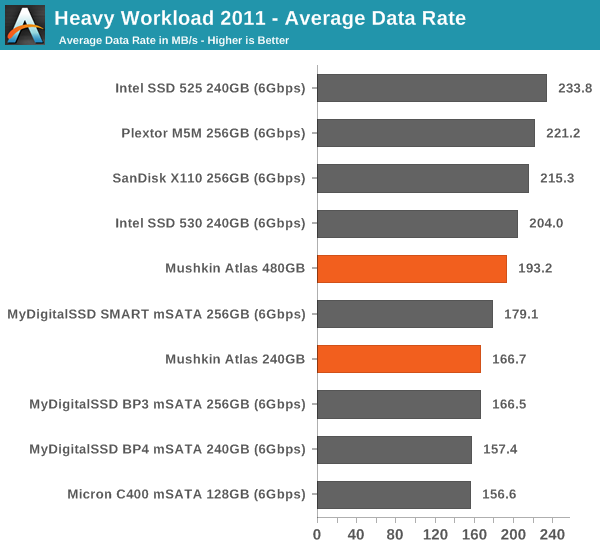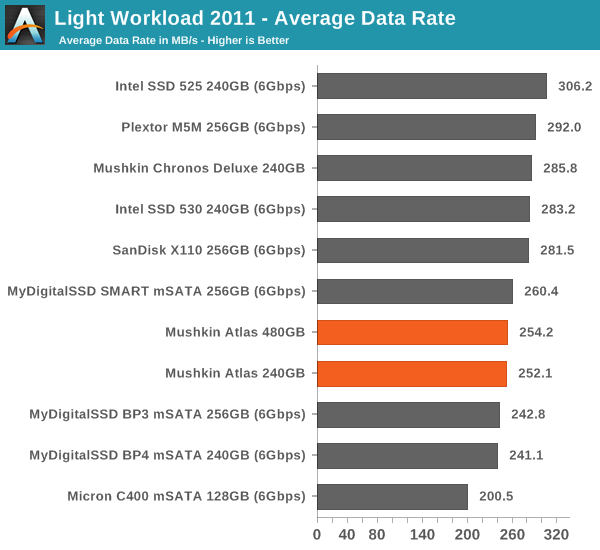Mushkin Atlas mSATA (240GB & 480GB) Review
by Kristian Vättö on December 16, 2013 1:10 PM ESTAnandTech Storage Bench 2011
Two years ago we introduced our AnandTech Storage Bench, a suite of benchmarks that took traces of real OS/application usage and played them back in a repeatable manner. Anand assembled the traces out of frustration with the majority of what we have today in terms of SSD benchmarks.
Although the AnandTech Storage Bench tests did a good job of characterizing SSD performance, they weren't stressful enough. All of the tests performed less than 10GB of reads/writes and typically involved only 4GB of writes specifically. That's not even enough exceed the spare area on most SSDs. Most canned SSD benchmarks don't even come close to writing a single gigabyte of data, but that doesn't mean that simply writing 4GB is acceptable.
Originally the benchmarks were kept short enough that they wouldn't be a burden to run (~30 minutes) but long enough that they were representative of what a power user might do with their system.
1) The MOASB, officially called AnandTech Storage Bench 2011 - Heavy Workload, mainly focuses on the times when your I/O activity is the highest. There is a lot of downloading and application installing that happens during the course of this test. Our thinking was that it's during application installs, file copies, downloading and multitasking with all of this that you can really notice performance differences between drives.
2) We tried to cover as many bases as possible with the software incorporated into this test. There's a lot of photo editing in Photoshop, HTML editing in Dreamweaver, web browsing, game playing/level loading (Starcraft II & WoW are both a part of the test) as well as general use stuff (application installing, virus scanning). We've included a large amount of email downloading, document creation and editing as well. To top it all off we even use Visual Studio 2008 to build Chromium during the test.
The test has 2,168,893 read operations and 1,783,447 write operations. The IO breakdown is as follows:
| AnandTech Storage Bench 2011 - Heavy Workload IO Breakdown | ||||
| IO Size | % of Total | |||
| 4KB | 28% | |||
| 16KB | 10% | |||
| 32KB | 10% | |||
| 64KB | 4% | |||
Only 42% of all operations are sequential, the rest range from pseudo to fully random (with most falling in the pseudo-random category). Average queue depth is 4.625 IOs, with 59% of operations taking place in an IO queue of 1.
AnandTech Storage Bench 2011 - Heavy Workload

Neither of the Atlases is able to compete with the fastest mSATA SSDs. It's surprising how big the difference is because Intel SSD 525 and the Altas are both SF-2281 based, but the SSD 525 is about 40% faster. Once again, the full data set (including read/write differentiation and disk busy times) can be found in our Bench.
AnandTech Storage Bench 2011 - Light Workload
Our light workload actually has more write operations than read operations. The split is as follows: 372,630 reads and 459,709 writes. The relatively close read/write ratio does better mimic a typical light workload (although even lighter workloads would be far more read centric). There's lots of web browsing, photo editing (but with a greater focus on photo consumption), video playback as well as some application installs and gaming.
The I/O breakdown is similar to the heavy workload at small IOs, however you'll notice that there are far fewer large IO transfers. Interestingly, the 480GB drive actually comes out ahead in this case, suggesting it's more capable at light workloads.
| AnandTech Storage Bench 2011 - Light Workload IO Breakdown | ||||
| IO Size | % of Total | |||
| 4KB | 27% | |||
| 16KB | 8% | |||
| 32KB | 6% | |||
| 64KB | 5% | |||











27 Comments
View All Comments
kwrzesien - Monday, December 16, 2013 - link
Avago to buy storage chipmaker LSI for $6.6 billion:http://www.cnbc.com/id/101275289
MichalSuchyn - Monday, December 16, 2013 - link
Love my job, since I've been bringing in $5600… I sit at home, music playing while I work in front of my new iMac that I got now that I'm making it online(Click on menu Home)http://goo.gl/O9CyBB
CharonPDX - Tuesday, December 17, 2013 - link
Spammer seems to be on the increase here - is there any easy way to report spam comments? (I can't find one.)hojnikb - Monday, December 16, 2013 - link
Yey another sandforce drive -.-Although one interesting point comes from all this...
Sandforce is actually working on fixing trim, which is nice to hear.
Gunbuster - Monday, December 16, 2013 - link
I've got a 240GB Mushkin MSATA in my Precision M4700. Runs like a champ.jrs77 - Monday, December 16, 2013 - link
mSATA is only of interest when talking either about switching storage in your ultrabook or your thin mITX system. For everything else a standard SATA SSD is better in price/performance.And for those ultrabooks or thin-clients performance isn't the first question, but price and silent operation.
So I'd say that this drive pretty much looses on all fronts, especially vs the Cruicial M500 240GB which is available currently for $144.99.
lmcd - Monday, December 16, 2013 - link
Or when talking about the mSATA in a larger notebook as the boot drive.MrSpadge - Tuesday, December 17, 2013 - link
I disagree: outfitting a regular laptop with one mSATA baby and a 1 or 2 TB 9.5mm height 2.5" HDD could be very welcome to power users not wanting 17" laptops with 2 drive bays. But of course these mSATA drives have to be priced competitively - there's no reason for them to cost more capacity.Hrel - Monday, December 16, 2013 - link
Plextor still seems to be the way to go here. Good to see Mushkin offering a legitimate alternative, but Plextor gets my recommendation for now.whyso - Monday, December 16, 2013 - link
Pretty poor drive. The high power consumption kills it in the mobile space.